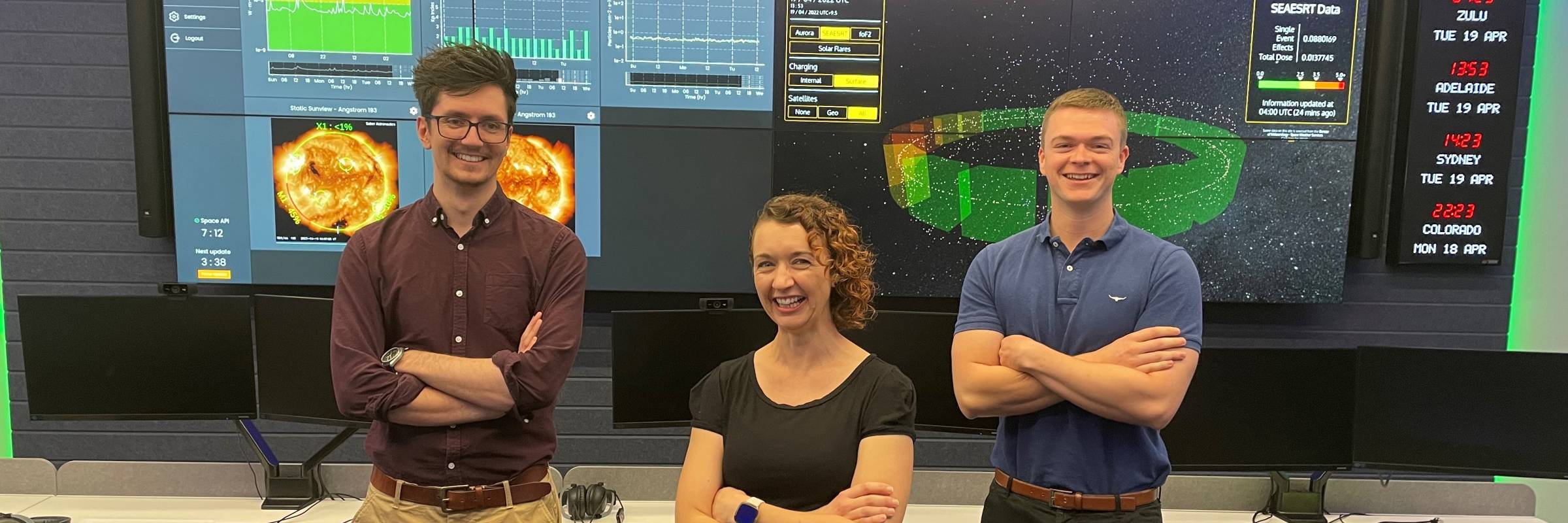From its Responsive Space Operations Centre at Lot Fourteen, Saber Astronautics and the Australian Bureau of Meteorology are at the forefront of international exercises that are working to help create a comprehensive space traffic management system.
It is estimated that, as of April 2020, there were a total of 2,666 satellites in space.
NASA says there are more than 27,000 pieces of orbital debris being officially tracked but there are yet more in the near-Earth space environment too small to be tracked but still large enough to threaten human spaceflight and robotic missions.
Since both the debris and spacecraft are travelling at extremely high speeds (more than 25,000 km/h in low Earth orbit), even a tiny piece of orbital debris can create very big problems.
Monitoring and tracking orbiting space-based objects, such as satellites and debris, to predict and evade collisions in space are all jobs taken on by Saber Astronautics Australia at Lot Fourteen.
This work is a growing field entitled space situational awareness and is all done via its Responsive Space Operations Centre (RSOC) at the innovation district.
“It’s in everyone’s best interests to work together to solve the larger space traffic management problem,” says Andreas Antoniades, Director of Saber Astronautics Australia.
“For example, let’s say an Australian satellite collides with another country’s satellite above Australia. Is it Australia’s problem? Is it the other country’s problem?
“The answer is that it’s everybody’s problem because a collision in space impacts the entire orbital plane and creates a debris cloud that can do enormous damage.”
It’s one of the issues being tackled by “Sprint Advanced Concept Training” events – ‘sprints’ for short – which are the largest joint commercial and defence space traffic exercises in the world. These week-long events are run by the United States Space Force and ‘follow the sun’, transferring through international jurisdictions as the earth revolves.
The drills involve more than 100 defence, commercial and government agencies from around the world in a massive, as-real exercise in space where live data from real-world sensors is used and the rules can change at any given moment.
Saber Astronautics Australia is responsible for coordinating the entire Asia-Pacific region for the exercises, with the bulk of its work happening at its Lot Fourteen RSOC, which opened in 2021 with the assistance of $6 million in funding from the Australian Space Agency’s Space Infrastructure Fund.
“The exercises involve us monitoring a rapidly evolving catalogue of hundreds of objects, and the agencies running the exercises will deliberately simulate alterations to objects in orbit or create an impending collision to see how quickly we can detect and respond to these changes,” says Andreas.
“By simulating incidents or trajectory changes that are injected into the main data streams, operators around the world can respond as a whole to scenarios and learn as a result. The learnings made by the commercial sector can benefit the defence sector and vice-versa.
“As the space industry, we are still trying to figure out the development of standards and policy that will govern automation, standardisation and international coordination in space.
“We need to solve the entire space traffic management problem, as we have the air traffic management problem, through global collaboration. So these exercises are about as important as it gets.”
Founded in 2008, Saber Astronautics operates multiple mission control centres, laboratories and hubs in Australia and the USA. Up to eight local Saber crew are involved in coordinating the Asia-Pacific exercises at the Lot Fourteen RSOC, with Saber Astronautics LLC based out of Boulder, Colorado participating from their own RSOC.
To calculate the potential collisions, Saber Astronautics uses specialised hardware to run computations that would be impossible to do efficiently with typical hardware. Whereas each calculation would take hundreds of seconds of typical compute time, the specialised hardware can do it in less than a second.

Image: Frank Gallagher – Flight Director and Tim Phillips – Space Operator & Engineer, Responsive Space Operations Centre, Saber Astronautics and Zandria Farrell – Space Sector Lead, Space and Space Weather, Bureau of Meteorology
More than 30 organisations including universities, government agencies and companies in the Asia Pacific region participate in the exercises including Lot Fourteen organisations, the Australian Space Agency and the Australian Bureau of Meteorology.
The Bureau provides space weather information and warning services to the Australian region and beyond. The Bureau works closely with the space industry and operations exposed to space weather risk – such as aviation, energy, defence and telecommunication industries – to tailor forecasts and warnings to their specific needs. Its space weather capability focuses on severe-to extreme events that may threaten critical infrastructure.
“Space weather impacts spacecraft and their operations and so it forms an input into space traffic management,” says the Bureau’s Space Sector Lead Zandria Farrell.
“The exercises allow us to build relationships with government and industry to help them understand the impacts of space weather and inform decision-making.
“The exercises have helped us learn about the range of stakeholders in the space situational awareness ecosystem which helps us deepen our engagement with existing and emerging customers, learning to better meet their needs through exposure to such activities.”
South Australia is the nation’s Space State with more than 100 space-related companies and Lot Fourteen home to the Australian Space Agency, the Australian Mission Control Centre and the Australian Space Discovery Centre.
This makes Lot Fourteen the ideal location for the Australian Bureau of Meteorology’s Space Weather Forecasting Centre and Space Weather Research Team.
“By being located alongside the nation’s burgeoning space industry, we can provide advice so industry is prepared to respond to space weather events and can reduce the risks of space weather impacts,” says Zandria.
“It can be energising and inspiring to see the range of activity underway and be a part of growing this national capability.”
Saber Astronautics is expanding into other areas of Lot Fourteen.
“I love the tight-knit community that Lot Fourteen has fostered,” Antoniades says.
“The fact that I can walk upstairs and engage with the Australian Space Agency, with the Bureau or any number of like-minded companies is creating a brilliant ecosystem that lets us play to each other’s strengths.”





